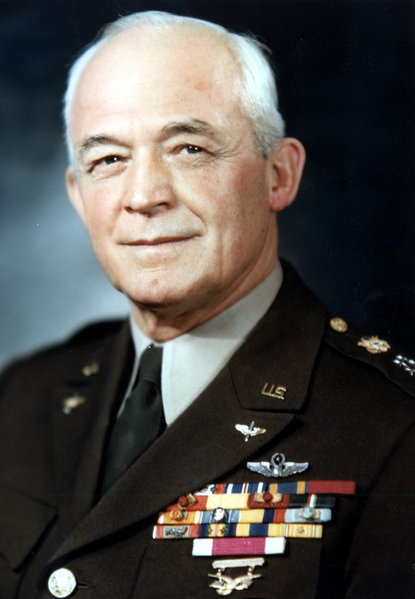Henry “Hap” Arnold was a United States general.
Arnold was born in Gladwyne, PA, in 1886. He attended the United States Military Academy, and was personally instructed by the Wright Brothers, becoming one of the first military pilots in United States history. He established an altitude record on June 1, 1912, when he flew to 6,540 feet.
During World War I, Arnold was stationed in the United States to work on flight logistics and training. His work during the interwar field was also focused primarily on research development as interest in air power gradually became more pronounced. In 1931, Arnold led a 7,360 mile roundtrip flight from Washington, D.C., to Fairbanks, Alaska. He received the Mackay Trophy, awarded annually by the United States Air Force, for his work on the trip, which required extensive logistically planning. The flight helped raise public interest in air force development.
In 1938, Arnold was named head of the Air Corps, which would soon become the Army Air Forces. He directed the AAF in both the European and Pacific theaters. Under his command, the AAF was vastly expanded, both in manpower and in equipment, as Arnold called for increased air power to counter that of Germany and Japan. In particular, Arnold pushed for the development of the B-29 bomber.
In 1944, Arnold was named a five star general. As commander, he traveled across the world to visit personally with his troops. He was also part of the negotiations at Tehran between the United States, the United Kingdom, and the Soviet Union. Arnold ordered and oversaw the extensive firebombing of Japan prior to the atomic bombings of Hiroshima and Nagasaki. He also helped ensure that Project Silverplate obtained all necessary materials and supplies.
Historians continue to debate whether Arnold favored or opposed the atomic bombings. Revisionists point to an interview on August 17, 1945, in which Arnold stated, “The Japanese position was hopeless even before the first atomic bomb fell, because the Japanese had lost control of their own air.” On the other hand, it does not appear that Arnold conveyed any reservations about the bombs’ use before Hiroshima and Nagasaki. Because he oversaw strategic bombing, Arnold likely wanted to emphasize its role in ending the war.
Before retiring from the military in 1946, Arnold helped lay the groundwork for what would become the United States Air Force, an organization equal with the Army and the Navy. He also founded Project RAND in 1946 to continue the benefit of civilian science to the Air Force. It would eventually become the RAND Corporation, a think tank which would play an important role in developing United States’ nuclear strategy during the Cold War. In an article he wrote titled “Our Power to Destroy War,” Arnold asserted, “What we will need is an adequate, well-trained, fully equipped force of whatever kind is necessary to use the new weapons and devices properly.”
Arnold died on January 15, 1950, in Sonoma, CA.





